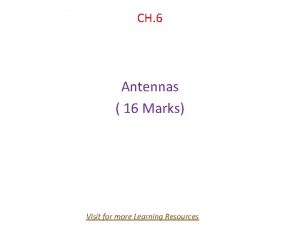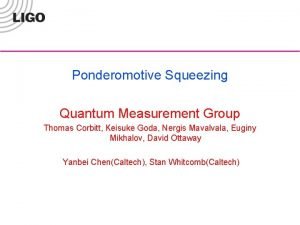Resonant modes in metalinsulatormetal metamaterials An analytical study

- Slides: 1

Resonant modes in metal/insulator/metal metamaterials: An analytical study on near-field couplings Shaojie Ma, Shiyi Xiao, and Lei Zhou* State Key Laboratory of Surface Physics and Key Laboratory of Micro and Nano Photonic Structures (Ministry of Education), Fudan University, Shanghai, 200433, China Authors: msj@fudan. edu. cn Supervisor : phzhou@fudan. edu. cn • Theory to describe MIM metasurface • Backgrounds: Magnetic resonance FP resonance J. M. Hao, et. al. APA. 87, 281 (2007) D. Yu. Shchegolkov, et. al. PRB 82, 205117 (2010) Fig. 2 Model of MIM metasurface Fig. 1 MIM metasurfaces have different resonance types Multiple mode expansion method (MEM): • Motivations: • Whether or not the near filed coupling plays an important role? • A unified framework can describe the resonance evolves • The transitions from one resonance type to another • Fundamental Resonance: • Shape slit: a<<d • Thin metal: hm<<1 • Subwavelength: d<<λ Effective Admittance: • High order Resonances: Resonance occurs when Yeff = 0 Left region: Magnetic resonance: hd<<1 Right up region: FP resonance Right down region: FP resonance: hd>>1 Two propagating modes are involved in high order FP resonances Fig. 4 resonance of high order resonance • Mode contributions for each resonance S 1 S 2 S 3 Fig. 5 Different types of resonance occurs in metasurface • Conclusions: Fig. 3 resonance and Q factor of first resonance A transition from magnetic resonance to FP resonance occurs with an increasing hd • With an various spacer thickness and frequency, resonance in metasurface has a transition from one type to another • Near field coupling effect dominates in thin spacer metasurface References: [1] F. J. Garcia-Vidal, L. Martin-Moreno, and J. B. Pendry, J. Opt. A: Pure Appl. Opt. 7, S 97 (2005). [2] H. T. Chen, Opt. Express 20, 7165 (2012). [3] Shaojie Ma, Shiyi Xiao, and Lei Zhou, Phys. Rev. B, 93, 045305 (2016).

